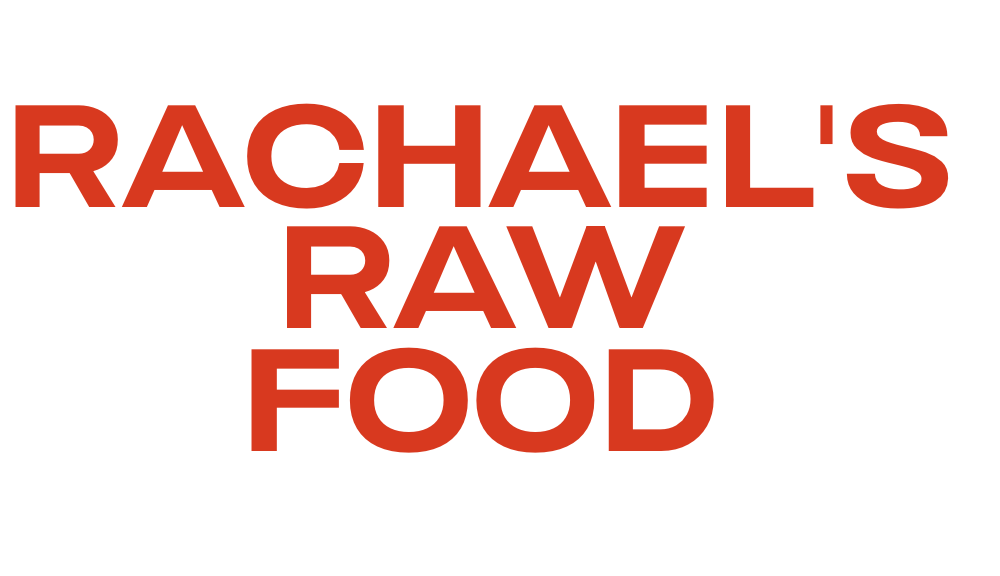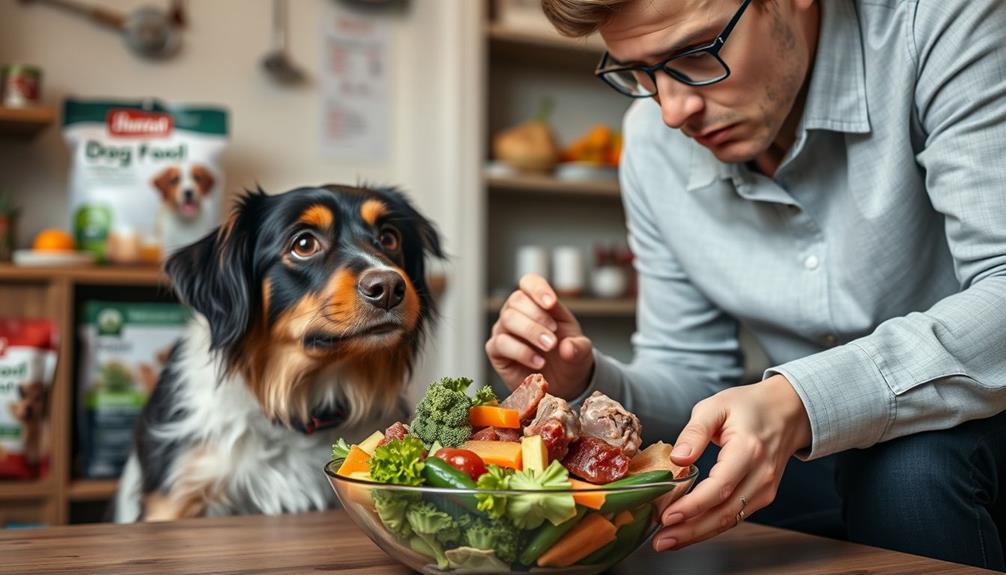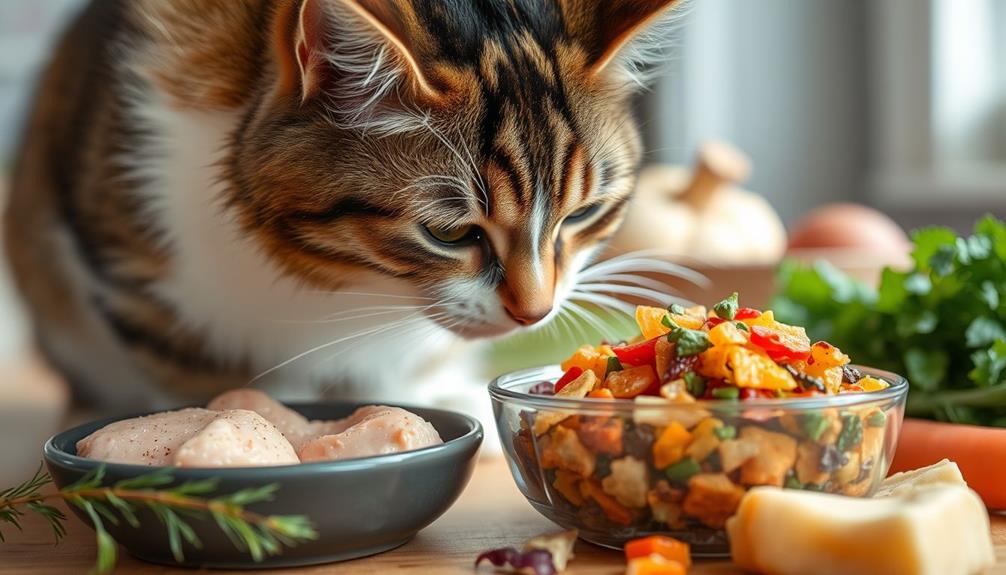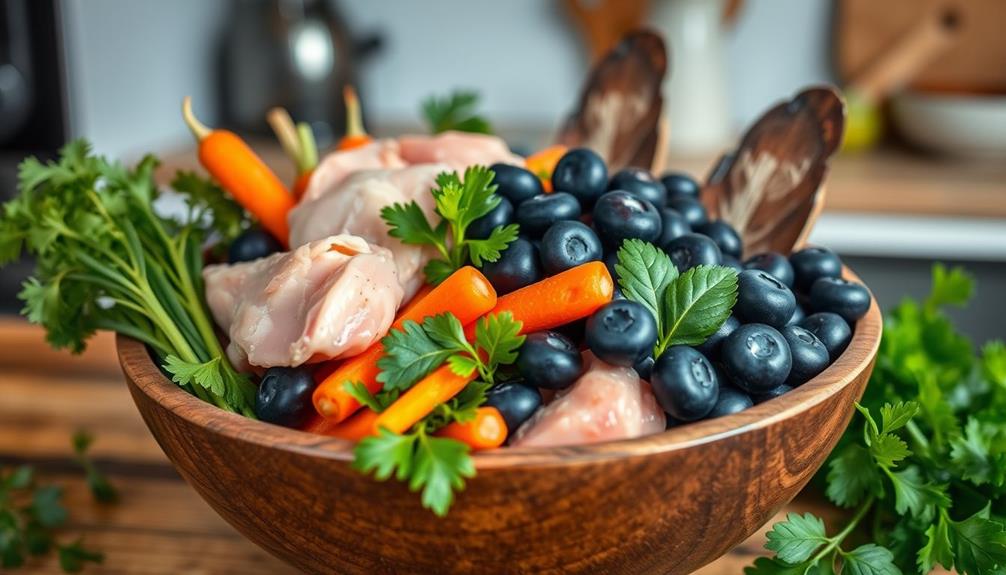To store raw food properly, keep it at safe temperatures—below 5°C (41°F) for high-risk items, like meat and dairy. Always place raw foods below cooked items in the fridge to avoid cross-contamination. Use sealed containers to protect your food and check your appliance temperatures regularly; the fridge should stay below 4°C (40°F). If any raw food's been in the danger zone (5°C to 60°C) for more than four hours, toss it out. Also, always conduct sensory checks for freshness. You'll find even more effective storage strategies if you explore further.
Key Takeaways
- Store high-risk foods below 5 °C (41 °F) or above 60 °C (140 °F) to prevent bacterial growth.
- Keep raw foods in sealed containers to maintain freshness and avoid contamination.
- Place raw foods below cooked foods in the refrigerator to minimize cross-contamination risks.
- Regularly check and maintain refrigerator temperatures at or below 4 °C (40 °F) for safety.
- Use proper thawing techniques by refrigerating or using cold water, avoiding room temperature.
Food Storage Guidelines
When it comes to food storage, following specific guidelines is essential for maintaining safety and freshness. To avoid spoilage and guarantee food safety, store high-risk foods, like raw food, cooked meats, dairy, and eggs, at temperatures of 5 °C or below or above 60 °C. This helps prevent bacterial growth and food poisoning.
Additionally, be mindful of how you handle these foods, as improper storage can lead to serious health risks, similar to how cold medications must be chosen carefully to avoid adverse effects and guarantee effectiveness.
For meat storage, always place raw foods below cooked foods in your refrigerator to minimize the risk of cross-contamination. Use suitable, covered containers to keep your food protected and organized.
Regularly check the temperature of your refrigerator, guaranteeing it stays at or below 4 °C (40 °F), and your freezer at 0 °F (-18 °C) for ideal preservation.
Additionally, keep an eye on use-by dates and promptly discard any high-risk foods that have been in the temperature danger zone, between 5 °C and 60 °C, for more than 4 hours.
Following these storage tips won't only help you maintain the quality of your food but also safeguard your health and that of your family. Stay vigilant, and you'll master the art of food storage in no time!
Understanding Temperature Safety

Storing raw food safely hinges on understanding the importance of temperature. To prevent harmful bacteria from multiplying, you need to keep your raw food at temperatures of 5 °C (41 °F) or below. Bacteria thrive in the danger zone, which is between 5 °C and 60 °C (41 °F and 140 °F). Always refrigerate or freeze your raw food immediately after purchasing, and remember the two-hour rule—don't let it sit at room temperature for too long.
Additionally, incorporating essential oils with anti-inflammatory properties can support overall health, which is vital when handling raw food.
Regularly check your refrigerator's temperature with a thermometer to guarantee it stays at 4 °C (40 °F) or lower. Your freezer should be at -18 °C (0 °F) or lower. When thawing raw food, do it in the refrigerator or under cold water, never at room temperature, to avoid entering the danger zone.
If any raw food has been stored in the danger zone for over four hours, discard it to reduce the risk of foodborne illness. By understanding these temperature safety guidelines, you can greatly lower your chances of bacterial growth and keep food safe for consumption.
Handling High-Risk Foods
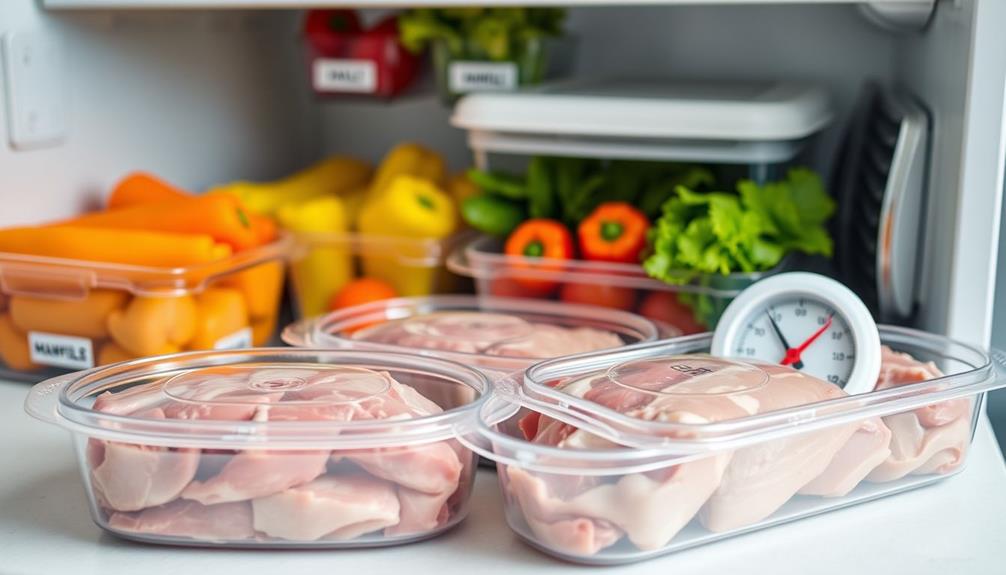
High-risk foods like raw meats, dairy, and eggs demand your attention to guarantee safety and prevent foodborne illnesses. You should always store these high-risk foods in the refrigerator at temperatures below 5 °C.
For ideal safety, keep raw meat in a secure sealed container below cooked foods to avoid cross-contamination. This method prevents any drips or spills from contaminating ready-to-eat items, which could lead to food poisoning. Understanding the importance of proper food handling and storage is vital, especially for caregivers managing the dietary needs of elderly individuals financial considerations for elderly care.
Seafood and prepared salads also fall into this high-risk category; handle and store them with extra care. If these foods have been left in the temperature danger zone for more than 4 hours, discard them immediately, as they may harbor harmful bacteria that pose serious health risks.
Proper storage methods are necessary to maintain the quality and safety of high-risk foods. Always check your refrigerator temperatures to verify they're consistently cold.
Safe Cooling and Freezing Techniques
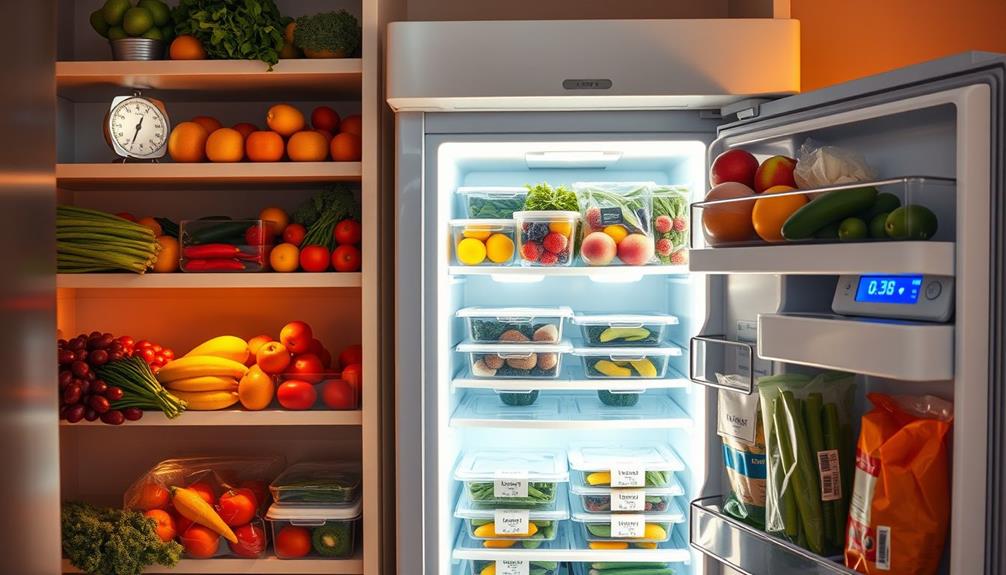
When it comes to storing food safely, using rapid cooling methods can make a big difference. You should always cool cooked food quickly by dividing it into smaller portions or using shallow dishes.
Additionally, guaranteeing good air quality in your kitchen can contribute to food safety, as air purifiers improve indoor conditions by reducing airborne contaminants.
Understanding freezing best practices guarantees your food stays safe and retains its quality.
Rapid Cooling Methods
To keep your food safe and fresh, it's crucial to cool it quickly after cooking. The longer cooked food stays in the temperature danger zone (between 5 °C and 60 °C), the greater the risk of harmful bacteria developing. To avoid this, divide large portions into smaller ones or use shallow dishes to allow for faster heat loss.
Additionally, consider using vital oils like eucalyptus oil for their antiseptic qualities, which may help in maintaining a clean cooking environment.
Before placing hot food in the refrigerator or freezer, use ice packs or an ice bath to rapidly cool it down. This helps guarantee that your food reaches safe temperatures of 5 °C or below promptly. Remember, never put very hot food directly into the refrigerator, as this can raise the internal temperature and compromise the safety of other items stored inside.
When transporting hot and cold foods, use insulated bags or coolers to maintain proper temperatures. If you need to thaw frozen food, avoid thawing it in the temperature danger zone; instead, thaw it in the refrigerator, under cold running water, or in the microwave if you plan to cook it immediately afterward.
For secure storage, always keep food in airtight containers once cooled.
Freezing Best Practices
Freezing food effectively can help you preserve its freshness and safety for longer periods. To guarantee you're following freezing best practices, always cool cooked food quickly in shallow dishes or smaller portions. This method prevents bacteria growth before freezing.
Remember, raw food should never be placed directly into the freezer hot; let it cool slightly at room temperature first. Additionally, freezing raw food can help maintain its nutrient absorption and overall quality, making it a great option for meal prep.
When you're ready to freeze, make certain all food products, including meat, are securely wrapped. Use airtight containers or freezer bags to prevent freezer burn and maintain quality. A thermometer is essential—check that your freezer temperature is at or below 0°F (-18°C) for ideal preservation.
Label and date all your frozen items to keep track of storage times. While frozen foods can remain safe indefinitely, they may lose quality over time.
Best Practices for Food Safety
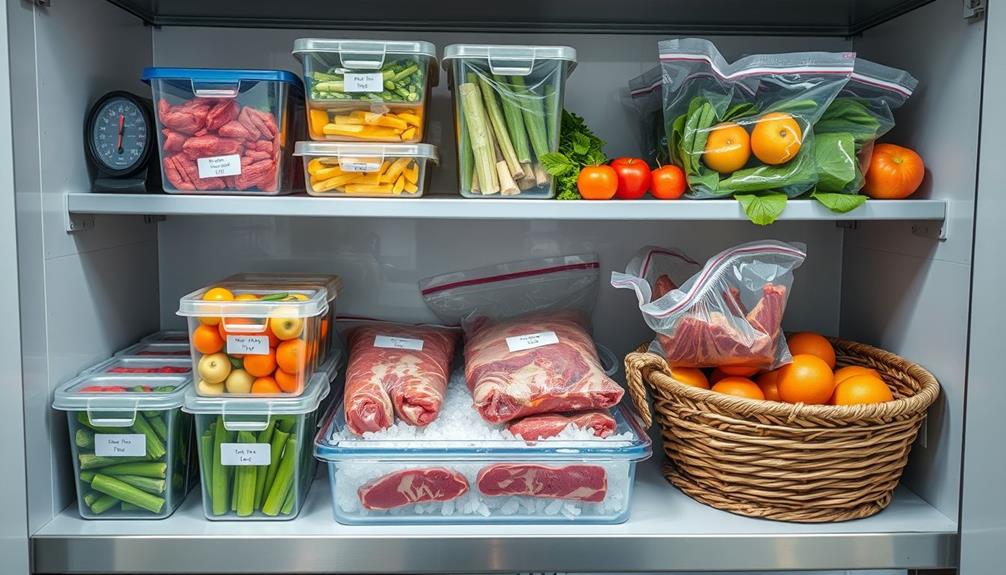
Storing raw food properly is essential for guaranteeing food safety and preventing contamination. To keep your food safe, always store raw items, especially high-risk ones like meats, dairy, and seafood, in the fridge or freezer at temperatures below 5 °C. This helps avoid the temperature danger zone where bacteria can multiply. In addition to proper storage, it is important to separate raw foods from ready-to-eat foods to prevent cross-contamination. Keep raw meats and seafood on the bottom shelf of the fridge to prevent any juices from dripping onto other foods. Also, make sure to clean and sanitize any surfaces or utensils that come into contact with raw foods. Despite the benefits of a raw food diet, such as increased nutrient intake and potential weight loss, it is crucial to handle and store raw foods properly to avoid the risk of foodborne illnesses.
A general rule is to keep raw foods sealed in airtight containers to maintain freshness and prevent moisture or odors from affecting other items. Additionally, having a solid budget plan can help you manage food costs effectively while guaranteeing you invest in high-quality ingredients.
Place these sealed containers on the bottom shelves of your refrigerator to prevent meat juices from dripping onto cooked foods or ready-to-eat items, reducing cross-contamination risks. Regularly check use-by dates to guarantee your food's shelf life remains intact.
When thawing frozen raw foods, do so in the fridge or cold water; never at room temperature, as this increases the risk of bacterial growth.
Lastly, always practice proper hygiene. Wash your hands, surfaces, and utensils before and after handling raw foods to minimize the chances of foodborne illnesses.
Sensory Checks for Freshness
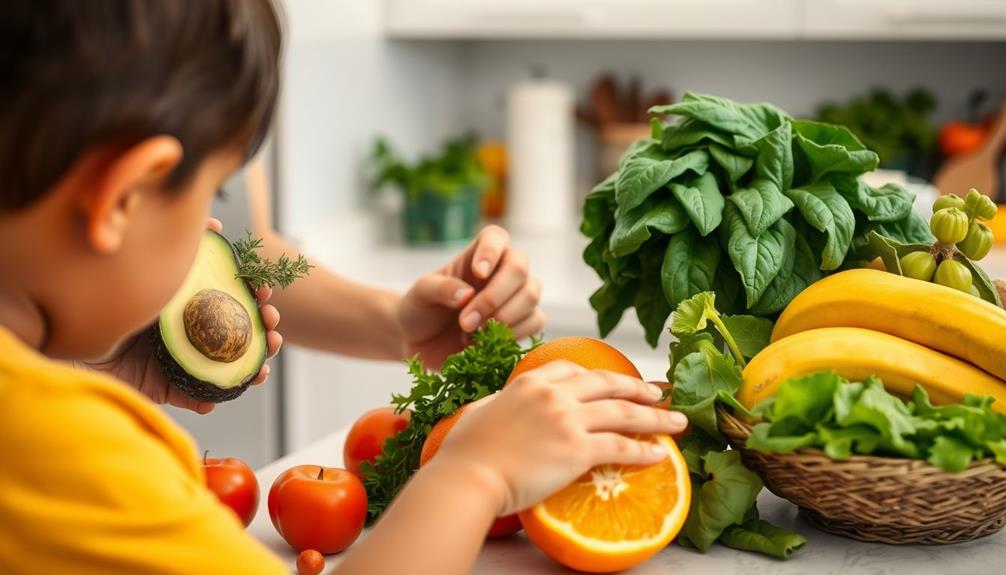
When evaluating the freshness of raw foods, a quick sensory check can reveal a lot about their quality. Start with a visual inspection; look for any signs of mold, discoloration, or changes in appearance. Fresh foods should boast vibrant colors, while dull or faded items may indicate spoilage.
Individuals with certain mental health disorders, such as emotional dysregulation, may have heightened sensitivity to their environment, making it even more crucial to evaluate food quality carefully.
Next, use your sense of smell. Fresh foods typically have a pleasant aroma, unlike stale or spoiled items that emit off-putting or sour odors.
Texture is another important aspect; raw foods should feel firm and crisp. If you notice sliminess or excessive mushiness, it's a strong indication of spoilage.
Don't forget about tasting as well—if the flavor seems off or unpleasant, discard the item to avoid foodborne illness.
Always check the use-by date, but remember that sensory checks are just as critical in evaluating freshness. By incorporating these sensory checks into your routine, you'll be able to identify potential contamination and guarantee you're only consuming the best quality raw foods.
Keeping these checks in mind will help you maintain the health and safety of your meals.
Frequently Asked Questions
What Is the Proper Way of Storing Raw Food?
To store raw food properly, keep it on the bottom shelves of your fridge, use airtight containers, maintain temperatures below 4°C, and regularly check for freshness by labeling and discarding expired items.
What Is the Best Order for Storing Raw Foods?
For safe storage, stack your shelves smartly: store ready-to-eat foods on top, fruits and veggies in the middle, and keep raw meats at the bottom. This way, you'll minimize contamination and maximize freshness.
What Are the Tips for Storing Raw Meat?
When storing raw meat, keep it on the bottom shelf, tightly wrapped to prevent freezer burn. Use separate cutting boards, label dates, and remember to thaw safely in the refrigerator or cold water.
What Is the Correct Way to Store Fresh Food?
To store fresh food correctly, keep it in the refrigerator below 5 °C. Use sealed containers, check for spoilage regularly, and guarantee cooked foods cool quickly. Always discard expired items for safety.
Conclusion
Just like a gardener tends to their plants, nurturing them with care, you too must cultivate your raw food storage habits. Imagine your fridge as a sanctuary, preserving the freshness of your ingredients like a safe haven for vibrant blooms. By embracing proper techniques and practices, you'll not only protect your food but also nurture your health. So, wield your knowledge like a gardener's tool, ensuring your culinary garden thrives with safety and flavor every day.
